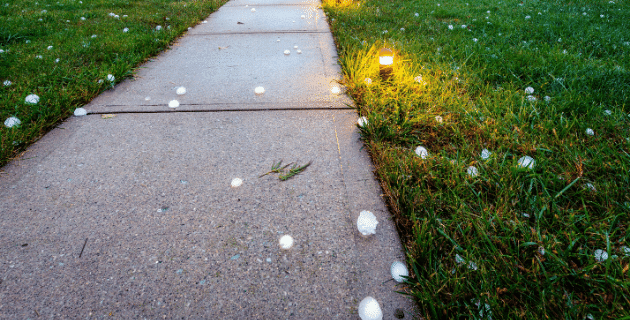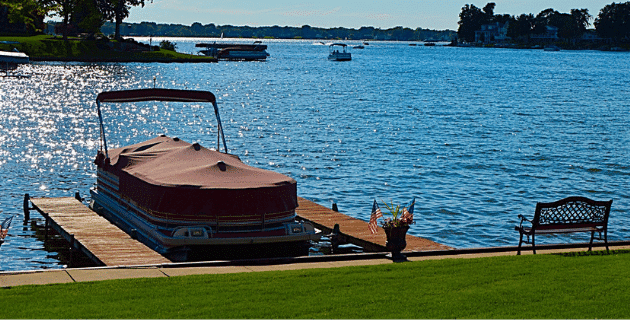
by California Casualty | Auto Insurance Info |
When you take your motorcycle out on a beautiful day, you can enjoy it all — the open road, the sunshine, the fresh air, and the calmness of the ride. But when you take your bike out on a windy day, it’s a much different experience.
Not only can the wind be cold and uncomfortable for riding, but it can also make it more challenging to maintain control. In fact, riding your motorcycle in the wind can be such a nerve-wracking journey that it might make you decide to skip the trip entirely. However, there will be times when you get caught on a windy day or when your bike is your only option. Follow these tips to stay safe when riding your motorcycle in the wind.
Tip #1: Prepare in advance for a windy ride.
-
- Minimize the amount of baggage that you carry. Saddlebags, backpacks, and even your clothing can catch the wind, creating unnecessary drag.
- Secure loose items that could be easily blown away.
- Wear protective eyewear to shield your eyes from any windblown dirt or debris.
Tip #2: Check the weather.
-
- Wind speeds exceeding 50 mph are considered too dangerous for motorcycles, even heavier models.
- Wind speeds between 20 and 30 mph will be too much for most lightweight motorcycles.
- Avoid taking your motorcycle out during high wind warnings, hurricane-force winds, tornados, or other severe weather conditions.
Tip #3: Stay calm and in control.
-
- Don’t panic. Relax and try not to grip the handles too hard. Maintain a steady speed.
- Ride in the middle of the lane. Give yourself some space in case you move to the right or left due to wind gusts. Know that the other vehicles on the road could be moved by the wind, too.
- Know your abilities. If you’re inexperienced, or if you feel out of control, find a safe place to wait it out. Better safe than sorry.
Tip #4: Know the direction of the wind and how to adjust.
-
- You may be able to feel the direction of the wind. But if you’re unsure, look for things that are blowing: grass, the tops of trees, and flags. Note the direction the wind is blowing.
- If it’s a tailwind, it will push you from behind.
- Give yourself extra stopping distance. The wind could propel you forward as you’re trying to slow and stop.
- Watch your speed and stay in your comfort zone. You don’t want the wind to push you faster than you are comfortable traveling.
- If it’s a crosswind, it comes from the sides.
- This is the most difficult type of wind. It can come to you from either side, or both.
- Shift your weight to the side the crosswind is coming from and lean into it slightly. Do it carefully so you don’t affect your balance.
- Using your leg on the side the wind is coming from, turn your knee in the direction the wind is blowing. Your leg acts as a sail and the wind won’t push you as hard.
- If it’s a headwind, it’s coming to you from the front.
- Headwinds are stronger than the wind that usually comes at you from the front.
- Ride low behind the windshield.
- Keep your legs and arms close to your body and to the bike.
Tip #5: Be aware of wind fluctuations.
-
- The wind direction can change at any time. Be prepared to adjust accordingly.
- If you’re behind a large truck, it will block the wind from you somewhat. Be prepared for a wind gust as you move away from the truck.
- Remember the rules about sharing the road with others. Add extra distance when it’s windy in case you need it.
Tip #6: Certain places are windier than others.
-
- Winds are generally higher in the hills and lower in the valleys.
- Roads with hedges and other barriers can help to protect you from the wind.
- If the open road is too windy, see if there is another route you can take that is more sheltered.
Windy conditions can contribute to accidents. Make sure your bike is fully protected with the right amount of motorcycle insurance. Safe travels—and enjoy the ride.
This article is furnished by California Casualty, providing auto and home insurance to educators, law enforcement officers, firefighters, and nurses. Get a quote at 1.866.704.8614 or www.calcas.com.

by California Casualty | Educators |
Our Education Blogger is a public school teacher with over a decade of experience. She’s an active NEA member and enjoys writing about her experiences in the classroom.
Virtual field trips allow students and teachers to go beyond the classroom, and even their own country and planet, to experience a variety of adventures all from the convenience of their seats at school.
They are a great end-of-the-year activity to help students have fun and really engage with their classmates. You can develop lesson plans and activities to complement your “trip”.
Here are some fun, educational, and free field trips to take with your class this May.

Museums
Smithsonian National Museum of Natural History Virtual Tour
This comprehensive virtual tour presentation allows visitors using a desktop computer (Windows, Mac, Linux) or a mobile device (iPhone, iPad, Android) to take virtual, self-guided, room-by-room tours of select exhibits and other areas within the natural history museum building as well as select research and collections areas at our satellite support and research stations and even past exhibits no longer on display.
The United States Holocaust Memorial Museum
The Museum’s collections database contains more than 270,000 records, including photos and albums—Images of life before, during, and after the Holocaust; Personal stories—Interviews, home movies, memoirs, and diaries; films—historical footage and contemporary films about the Holocaust.
National WWII Museum
The Online Learning Series allows an unprecedented look into the Museum’s collection for those WWII enthusiasts the Museum can’t always reach in person.
The Louvre
Visit the museum’s exhibition rooms and galleries, and contemplate the façades of the Louvre.
The Van Gogh Museum
The Van Gogh Museum in Amsterdam houses the largest collection of artworks by Vincent van Gogh (1853-1890) in the world. The permanent collection includes over 200 paintings by Vincent van Gogh, 500 drawings, and more than 750 letters. Discover his work, read stories, walk the museum, and more.
Virtual Colonial Williamsburg
Immerse yourself in an interactive 3D model of Virginia’s 18th-century capital. The project integrates architectural, archaeological, and historical information, presenting the city as it has not been seen in more than 200 years.

Go On A Journey
Reach The World
Since 2009, 930 travelers have shared their journeys online with more than 17,000 youth in the U.S., publishing more than 16,000 first-person travelogues in the process. By using technology to enable youth to form relationships with global travelers, RTW is sparking a process of personal development that can truly be described as “reaching” the world!
National Aquarium
Visit the famous, Baltimore aquarium where kids can have fun learning while exploring different regions, like the tropics and the tundra.
Seattle Aquarium
Take a tour of the wonderful Seattle Aquarium, watch live webcams and videos, download animal infographics, factsheets, and more!
Monterey Bay Aquarium
Experience the wonder of the ocean wherever you are with 10 live webcams including penguins, spider crabs, jellyfish, and sharks. Read animal stories, learn about their habitats, and more.
San Diego Zoo
The San Diego Zoo has ten live cams to choose from! The zoo also has a website for kids that is full of videos, activities, stories, and games!
Smithsonian’s National Zoo
See giant pandas, elephants, lions, and naked mole rats on animal cams streaming live, 24/7 from the Smithsonian’s National Zoo and Conservation Biology Institute. Enjoy free webinars on their website AND download Animal Cam Bingo Cards.
National Parks
Take a trip to a national park from wherever you are! Many national park sites across the country offer digital tours and experiences that you can access anytime, anywhere. From digitally diving under the sea to watching webcams of the cherry blossom trees bloom, there are countless ways to enjoy a park experience online.

World Destinations
New York City and Ellis Island
Take a virtual tour of one of the most famous cities in the world, and explore its top tourist destinations like Madison Square Garden and the Empire State Building. And then head on over to Ellis Island and take their “Coming to America” virtual tour.
Goodrich Castle
Located near the Anglo-Welsh border, Goodrich Castle is one of the finest and best-preserved of all English medieval castles. Take a virtual tour of the castle, learn its ownership and siege history, what life was like in a medieval household, and more.
Buckingham Palace
Explore this magnificent building via virtual tours. The first tour will take you to the Grand Staircase. Click on the small images below to access further tours of the White Drawing Room, the Throne Room, and the Blue Drawing Room. And then scroll to the bottom to read about the events, residents of the palace, and more.
The Great Wall of China
From the sea to the desert, walk the Great Wall of China, read about its history, and uncover secret stamps within its bricks!
The Pyramids of Egypt
Take a 360-degree virtual reality tour of the Egyptian Pyramids and then brush up on your history with Smithsonian Journeys: Ancient Egypt and the Nile
Rome & the Colosseum
Take a journey around the iconic sights of Rome with this virtual tour of the historical centre and the Colosseum.
The Eiffel Tower
The best panoramic views from the Eiffel Tower, both day and night. The mobile guide lets you admire Paris as if you were on the 2nd floor, or at the Tower’s summit. Scan the horizon to the right or left, activate night mode, and zoom in to see Notre Dame Cathedral, Place de la Concorde, the Hôtel des Invalides, and many other Parisian monuments. You can even click the description at the bottom to learn more about what you are seeing.

& More!
National Geographic Education
National Geographic Education brings geography, social studies, and science to life. Using real-world examples and National Geographic’s rich media, educators, families, and students learn about the world and the people in it.
Google Arts and Culture Street View and Google Arts and Culture Places
Tour famous sites and landmarks around the world.
AirPano
AirPano is a project created by a team of Russian photographers focused on taking high-resolution aerial 360° photographs and 360° video. Today AirPano is the largest resource in the world — by geographical coverage, a number of aerial photographs, and artistic and technical quality of the images — featuring 360° panoramas and 360° videos of the highest quality shot from a bird’s eye view.
Your students can also explore Disney World with our fun Virtual Tour of Disney World rides!
Happy “touring” 😉
This article is furnished by California Casualty, providing auto and home insurance to educators, law enforcement officers, firefighters, and nurses. Get a quote at 1.866.704.8614 or www.calcas.com.

by California Casualty | Auto Insurance Info, Homeowners Insurance Info |
Hail is responsible for billions of dollars of damage each year, according to the Insurance Information Institute. It only takes one bad hailstorm to damage your roof or siding, dent your vehicle or crack your windshield. Knowing what to expect, along with having the right auto and home insurance, will help you to protect your biggest investments.
What causes hail?
Hail commonly occurs during severe thunderstorms. It’s formed when storm winds carry rain up into the extremely cold parts of the atmosphere. The rain freezes, comes in contact with more rain that freezes to it, and ultimately becomes a chunk of ice. Eventually, the hailstones grow heavy and fall to the ground.
Hail can be as small as the size of a pea or as large as a softball. Most hail, however, is golf ball-sized or smaller. Windspeeds can cause hail to hit at a rate between 44-72 mph. Hail mixed with high winds has been known to cause severe damage.
What damage can hail do to your home?
ROOFS: Roof damage from hail is common. Large pieces of hail can make dents in shingles and destroy the roof’s finishes. Different types of shingles show damage in different ways. For asphalt and composition shingles, look for dings that are black in color or soft to the touch. They may resemble a bruise on an apple. Also, look for loss of granules on asphalt; the shingles may appear shiny. For wood shingles, look for splits that are brown or orange and have sharp edges. Damaged shingles can cause your roof to leak or create water damage to the structure below. Getting these fixed is important to keeping the integrity of your roof.
Pro-Tip: Are you renovating your home? Consider impact-resistant shingles that can withstand hail. Not only will they help to reduce damage, but they may also help you qualify for a discount on your property insurance.
SIDING: Hail can cause dents in aluminum siding and cracks in vinyl or wood siding. Water can seep in and cause problems. Look for warping or buckling, chipping, cracks, dents and holes. It’s best to do this when the sun isn’t too bright, as it could cast shadows and prevent you from seeing the damage. Again, get any damaged siding fixed as soon as you are able.
GLASS: During a hailstorm, stay away from skylights, windows, and glass doors, which are at risk for breakage from hail. Close your drapes, blinds, or shades in case a broken window occurs. This can help keep some of the glass from being blown around your house. Also, you may choose to install shutters which can help to protect your glass. You have a responsibility to make reasonable and necessary repairs to protect your property from further damage, as per your insurance contract. Your insurance company might reimburse you for these costs.
PATIO FURNITURE: Protect your patio furniture by covering it, or moving it inside a garage. Prune your trees ahead of time to remove weak or dead branches that can cause additional problems.
What damage can hail do to your car?
WINDSHIELD AND WINDOWS: Similar to the glass in your home, your car’s windshield, windows, and sunroof can be cracked or even shattered by hail. Cover your vehicle with a car cover. You can buy one or make your own with blankets. Secure the blankets with duct tape; while it may leave a sticky residue, it will not damage your paint.
CAR BODY: Hail can dent your car’s body as well the glass and a car cover can help. If a hailstorm is coming, park your car under an awning or in a garage. You can move your car to a local mall with a parking garage if you don’t have one. If you are driving during a hailstorm, pull over. Angle your car so that hail hits your reinforced windshield rather than the side and back windows.
What kind of insurance do you need?
You can’t control the weather, but you can purchase the insurance that keeps your home and your vehicle protected in case they are damaged by a hailstorm. These policies will give you the money you need to repair or replace covered items, subject to your policy deductible.
HOME PROTECTION
In most states, hail is one of the covered perils in a homeowner’s policy. Your dwelling coverage pays for repairs to your roof or siding while detached structures fall under “other structures coverage.” If hail gets inside and damages belongings, that can be covered under homeowner’s insurance. For personal property to be covered, the direct force of the wind or hail must damage the building, causing an opening in a roof or wall. You unfortunately won’t get any coverage if you leave the window or door open.
-
- If you live in a state that is prone to hailstorms, you may not be covered. You may have to purchase an endorsement to your policy or even a separate windstorm and hail policy to be covered for hailstorms.
- Your policy may have an exclusion for cosmetic damage to the roof and/or siding. If the damage done by hail is cosmetic, your policy will not pay. Cosmetic damage is considered damage that does not prevent the roof surface or siding coverings from functioning as a barrier to weather elements over an extended period of time.
- Depending upon the age of your roof (typically 10 years of age or more), actual cash value loss settlement could apply, meaning that you’ll receive an amount based on depreciation.
- If the damage isn’t higher than your deductible, you probably don’t need to file a claim. You can pay out of pocket, as insurance only kicks in after the deductible is met.
AUTO PROTECTION
Not all auto insurance policies cover hail damage. You have to have the right type of coverage.
-
- Other Than Collision Coverage or OTC is for natural disasters, fires, vandalism, theft, and animals that damage your vehicle. Think of it as “bad luck coverage.” This coverage is not usually required unless you’re leasing a vehicle or paying a car loan. However, it’s valuable to protect your car from hailstorm damage.
- If your car needs to stay in the shop, you will want an insurance policy with Transportation Expenses coverage, also known as rental reimbursement. If you carry coverage for damage to your auto, your California Casualty policy automatically includes coverage for a rental car up to $20 a day. For an additional fee, you can increase that amount.
- If hailstorms damage your car to the extent that it is totaled, your insurance policy will likely pay you for the actual cash value of your car.
Talk to your insurance agent to see what is covered under your policy before the next hailstorm strikes. That way you’ll be fully prepared.
This article is furnished by California Casualty, providing auto and home insurance to educators, law enforcement officers, firefighters, and nurses. Get a quote at 1.866.704.8614 or www.calcas.com.

by California Casualty | Auto Insurance Info |
This time of year, boat owners are getting their boats out of storage and ready for the water. If you’re among those eagerly anticipating the new boating season, you’ll want to make sure you’ve done everything to get your boat prepared and ensure you’ll be boating safely.
Follow this checklist for spring boat maintenance before you take off for the first time this season! (Friendly reminder, you can do much of this basic maintenance yourself, but if you’re unsure, always consult a professional boat mechanic.)
1. Inspect the Battery.
After sitting idle for months, your battery will likely need attention. You will want to make sure that it’s fully charged and ready to go. There are three basic types of boat batteries: AGM (absorbed glass mat), gel cell, and lead-acid. When working around batteries, always use eye protection, wear gloves, and never put your face near a battery.
-
- If you have a lead-acid battery, you need to top off the fluid with distilled water. Remove the caps and use a flashlight to check the level. Add the water so it just covers the top of the plates. Be very careful doing this, as bubbles can pop and splash acid.
- Use a meter reader to check the charge on your battery. Set the meter so it’s reading DC volts. A full charge is in the range of 12.65 to 12.77 volts. A dead battery measures 11.75 to 11.89 volts, so the numbers are pretty close. If you have a lead-acid battery, you can use a battery hydrometer instead of a meter reader.
- Make sure not to overcharge or undercharge your battery. Both can limit its lifespan. Consider a marine-smart battery charger, which is permanently installed.
- Use a wire brush to clean the battery terminals. Fill the cells with distilled water.
- Check and tighten the cable connections to your battery. Loose connections can create a fire hazard.
- Make sure that there is a lid on the battery box to prevent short circuits.
2. Check the fuel system.
Your fuel system encompasses more than your gas tank. It involves hoses, and if your boat is older, a carburetor. You want to check it to make sure that it’s in good working order.
-
- Inspect your fill and vent hoses. Look for brittleness or cracks and replace any as needed with U.S. Coast Guard-approved hoses.
- Look for stains around fuel line clamps and fittings. Check for smells around the fittings. If you find any, replace those fittings so you don’t have a dangerous leak.
- If you detect a smell, you may want to check your fuel tank for leaks.
- Check for water in your fuel tank.
- Fuel your boat with gasoline that does not contain ethanol. If you only have ethanol blends available, choose one with less than 10 percent ethanol.
- Use a fuel stabilizer additive if you’re not going to be using up the gas in your tank within a week or two.
3. Examine the engine.
There are several components in your engine that wear down over time. Now is your chance to give them a look and make sure that they do not need replacement.
-
- Inspect the belts and cables to make sure they’re not cracked.
- Replace the spark plugs as needed.
- Look for rust or any indication that clamps or other parts may need replacement.
- If you didn’t do it before you stored your boat for the winter, change the oil and filter, and the drive lubricants.
- Check the fluids for your power steering and coolant and top them off if needed.
- Check the impeller pump to make sure it’s not worn. Impellers bring cooling water to the engine and are necessary for its safe operation. They should be replaced every 2 years or after 200 hours of use.
- If your boat has lights, make sure they are functioning.
4. Check the boat’s hull.
The hull or bottom of your boat comes in contact with water, which means that its parts may deteriorate over time.
-
- Check your boat’s anodes. These protect underwater areas of your boat from corrosion. If you see that your anodes are half dissolved, you will want to replace them.
- Reinstall sea strainers for raw water cooling. If they weren’t properly drained for the winter, check for damage by ice.
- Install the drain plug for your boat trailer if you removed it last fall.
5. Get out your cleaning supplies.
After a winter of just sitting around, your boat will naturally be dusty. You want to make sure that you give it a good cleaning, and also check for any potential problems like mold.
-
- Choose a mild detergent for the exterior, then add a coat of wax.
- Use an all-purpose spray cleaner for the console.
- Use a vinyl cleaner on the seats.
- Wipe down windows.
- Clean carpets with a power washer.
- Take note of any areas that have a smell or may have had water. The moisture can cause mold, which you will want to remove completely and as soon as possible.
6. Stock up on safety essentials.
Your old safety gear may be in good working order or it may need to be replaced. Now is the time to check.
-
- Make sure you have enough life jackets, and that they are in good condition and easily accessible.
- Check your safety kit. You should have first aid supplies, flares, fire extinguishers, and flashlights in a waterproof container. Make sure your extinguisher is mounted where you can easily reach it.
- Check the expiration date on your fire extinguisher and your flares. Replace them as needed.
- Test your boat’s smoke and carbon monoxide alarms.
- Take advantage of the U.S. Coast Guard vessel safety check.
7. Check your trailer.
If you transport your boat via a trailer, spring is a good time to check-in. You don’t want any issues getting your boat to the water.
-
- Make sure your trailer’s brake lights are working.
- Check the tires. Look for cracks in the sidewalls. Most trailer tires don’t wear out their tread but they can crack from exposure to the elements.
- Check the tire pressure. Make sure you have a spare tire.
8. Get your papers in order.
Before you take your boat out, make sure that you have the right paperwork. This includes documentation for insurance so that you are fully protected in the event of a boating accident.
-
- Review your boat insurance. Make sure it’s up to date and you understand what’s covered.
- Keep your boat registration handy.
- Make sure you have a fishing license and trailer tags as needed.
Happy boating!
This article is furnished by California Casualty, providing auto and home insurance to educators, law enforcement officers, firefighters, and nurses. Get a quote at 1.866.704.8614 or www.calcas.com.









